Steve Holt, Garry Lambert, and Small Wonder audio componentry
I’ve done a few interviews related to crowdfunding campaigns for audiophile components. I think it’s an interesting phenomenon, and the number of audio products being launched this way seems to be increasing. Right at the time I’d been wondering about experimenting more with “separates” in my modest desktop/headphone system (instead of all-in-ones), what should come along but a crowdfunding campaign for a very cute little hybrid tube/MOSFET headphone amplifier from the Lambert Company of New Zealand and The Audio Nerd, their US representative.
I over-simplify, though. The Lambert Company and The Audio Nerd are actually launching a full range of audio components that they call “Small Wonder.” In addition to the headphone amplifier, called Play it By Ear, the product line includes a preamplifer (Control), power amplifier with subwoofer output signal (The Force), monoblock power amplifiers (The Full Force), and a 2.1 loudspeaker system called The Last Word (speakers) and The Bottom Line (subwoofer). It’s all small and neat, designed to work well together, and judging from the descriptions given, should sound really excellent. I wanted to know more! Steve Holt from the Audio Nerd and designer Garry Lambert were kind enough to field my questions.
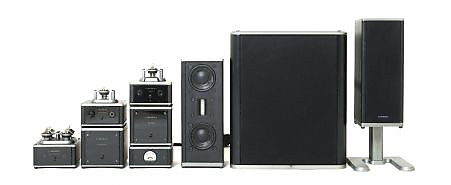
JR: You’ve both been involved in the audio industry for quite some time. But tell us how it all started for each of you. What got you interested in audio playback equipment in the first place?
GL: Elvis. Thus a guitar, thus a need for an amplifier – which I built but it didn’t work – thus a career in electronics engineering plus music. My interest is in music, and audio playback equipment is a means to an end – not the other way around.
SH: Like Garry, I am also a musician. I’ve been playing guitar and anything with strings since I was a pre-teen. I love music, sound and the science of sound. In my late 20’s I went to Electronic Engineering school. There I found my way into the audio industry thru the telecom and aerospace industry. My love has always been of audio.
JR: And you worked together at Tara Labs, if I understand correctly? What brought you back together for this venture?
SH: Garry and I worked together about 3 years at Tara. When I left we would still see each other regularly. It was a small town. I eventually moved to the Sacramento area to work for MIT. I didn’t hear from Garry for a few years after that, but social media being as it is, we connected again about 3 years ago and started talking about Garry’s idea for the Small Wonder series. Here we are today.
GL: We’d kept in touch, and I visited CES some years ago to see where the industry was (I’d avoided CES since leaving TARA/EAD – burned out from it) and we just started talking about where product was or was not meeting people’s needs – and I don’t mean just audiophiles.
JR: Why crowdfunding?
SH: Well, I left MIT cables back in September of 2013 and went to work for Light Harmonic with Gavin Fish and Larry Ho. They really impressed me with the Geek Out campaign. I joined their company and was instrumental in the Geek Pulse campaign – which turned out to be one of the most successful crowdfunding campaigns ever. That was over a year ago and they are just starting to ship some of those products. I ended up leaving LH right before the Geek Wave Campaign to do The Audio Nerd full-time, as I’d been running it part-time since 2006. It was a choice I had to make.
Garry had already done all the proving and designing of his products, all that was needed was money to turn the lights on at the factory and start building them. I realized that Garry’s products could be a hit with people who had been reluctant to get into crowdfunding due to the long period of time that they normally have to wait for the products they back. We are guaranteeing that we can have all of the products delivered – not just shipped, but delivered – no later than 4 months after the campaign ends. It’s a great way to get people to know about our company and get things rolling.
JR: Not only that, but the first 25 headphone amps will ship as soon as you reach your funding goal!
SH: The Play It By Ear headphone amp is the only product at Lambert that has had a production run. Meaning we’ve manufactured around 50 of them. Several of them have made their way into the hands of reviewers and about 30 or so are in my warehouse at The Audio Nerd. As no one really knows who we are, I thought making those available quickly would be a great way to get some into people’s hands before the crowdfunding campaign even ends.
JR: Are there any downsides to the crowdfunding approach?
SH: No. I can’t think of a better way to get your name out there, raise capital and start doing business than crowdfunding. It really allows you to reach a global audience and connect with them in a way that print ads or web banners don’t, or would take a massive advertising budget to attain the same results.
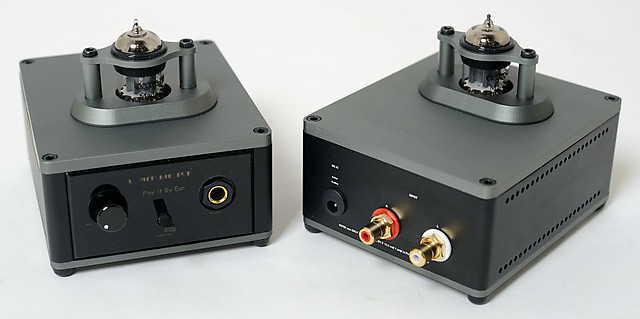
Play it By Ear headphone amplifier
JR: I’m curious about some of the technical aspects of the products you’re launching. The Play it By Ear is a hybrid using a tube for amplification and a single-ended MOSFET output stage – is that it? I mean, are there other active components, or is the topology as simple as it sounds?
GL: There is a current regulator in series with the MOSFET, but the signal chain is as simple as that sounds. And always should be. All you can ever do between the original music and your ears is lose information. You can’t “enhance” it. You can’t recover lost parts.
JR: Why did you choose this particular topology?
GL: I still love the magic of tubes, but they have limits in power stages. That’s it.
JR: Play it By Ear is powered by an external 19 VDC supply. Is there a DC-DC convertor internally or does the 12AU7 run directly from 19V?
GL: It actually runs on 15 volts. There is even further filtering and regulation inside the Play it by Ear chassis.
JR: Your amp doesn’t try to impress with specifications of Watts of output power, yet it’s enthusiastically endorsed by a number of people for use with Audeze headphones, including Alex Rosson, CEO of Audeze. I’m guessing that, as with amplifiers for speakers, it’s more complicated than just a simple power output number. Could you elaborate on that a bit – what makes a headphone amp really good at driving headphones?
GL: We make the product to perform under as many conditions as we can imagine. If I had my way, I wouldn’t publish specs. There are people who read them and form a preconception of what the product will sound like. The important part, in any case, is the low-level detail. Always. That’s where all the “space” and “image” lurks.
SH: The “specs” do not determine the product. But you are right, the specs on the headphone amp are at about 100 mW output into 32 ohms. You cannot believe how much output power the headphone amp has when listening to it. It shocks just about every one when they try it.
JR: The Control (preamp) also has a single tube. Is it a hybrid too?
GL: Not a hybrid. Look at it as a passive pre-amp with some gain, albeit tube gain.
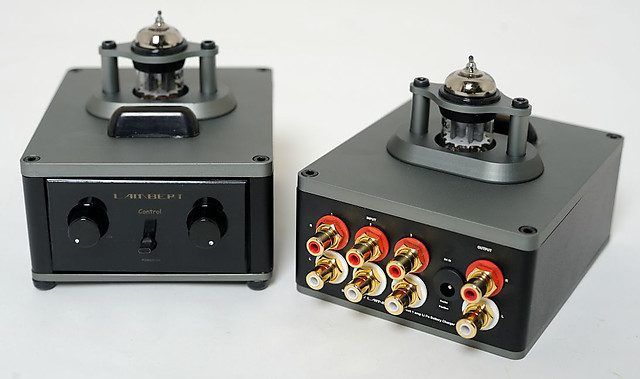
The Control preamplifier
JR: I’m intrigued by the Bluetooth capability of the Control. Could you just walk through the procedure for those of us who aren’t familiar with Bluetooth audio?
GL: Basically, you switch the input on Control to position #4, and the blue light in the BT window on top will start to flash. Take your phone (and I trust you are using a phone capable of at least CD quality music files – and preferably includes APTX for BlueTooth). The discover feature of your phone should find “Lambert” and then you pair. Done. Play some music.
JR: So that will play CD quality… what about 24/96?
GL: Currently, 24/96 is too high for the BT format.
JR: What’s a typical distance you can use it up to?
SH: I’ve been able to stream from my Samsung Note 4 up to about 35 – 40 ft outside the building at my shop.
JR: While presumably there must be a DAC in Control for the data coming in over Bluetooth, there’s no standalone DAC unit in the Small Wonder series?
GL: DACs are constantly improving/changing and our thrust is really the analog side of audio. We have no plans in this direction. Yet.
SH: As Garry says, we are more of an analog company. There is no shortage of DACs out there in the market today that are fighting the “resolution war” from 44.1 to DSD 256. But it all has to go analog at some point. We’re here to catch it there. Use whatever DAC you like, and we’ll be able to transmit the signal quite nicely for years to come, whatever resolution is to come.
JR: On the Lambert webpage I see a mysterious component, the same size as the Play it By Ear and the Control, but which has four tubes. Is that a forthcoming product (phono preamp perhaps)?
GL: Perhaps [winks]. Actually, there are a number of peripheral products in the same form factor that I’m “playing” with. That doesn’t mean they will or will not see the light of day. It more or less depends on our acceptance as a product line, and as a company.
JR: Your power amplification – Force, Full Force, and the amplifier in the Bottom Line subwoofer – uses B&O ICEPower modules. Could you tell us why you chose ICEPower?
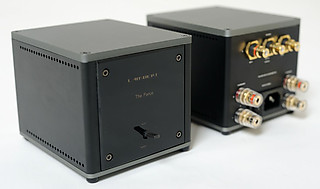
The Force stereo power amplifier
GL: During my time at TARA/EAD, I had the opportunity to test and listen to a number of amplification modes – giant Class A amps, IC-based amps (POWERMASTER 8000 for example). In the process I gained respect for the ICEpower philosophy. So when I developed Play it By Ear and Control, I approached B&O to try their latest offerings. As a company they have been superb, because obviously we are small and relatively unknown, and yet we got a lot of assistance. And I wanted to keep the same form factor. I have found the combination of the tube pre and Class D power to have a beautiful balance. It also fits my desire to keep it all small, neat, and affordable.
JR: The Last Word speakers and the Bottom Line subwoofer are designed to work together. I gather that they are also really best used with the Force (stereo amplifier), as the Force has the subwoofer output signal needed by the Bottom Line. The Full Force (mono block amplifiers), on the other hand, are really intended for use with your existing speakers, especially if they need more power. Do I have that right?
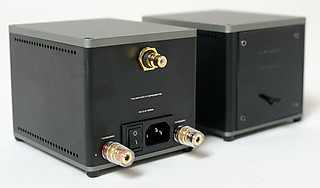
The Full Force monoblock
GL: Yes. Like a lot of other people, I also have a set of floor-standing speakers (and a history of designing them, so they are my own work), so Steve and I reasoned that we needed this option in our range.
SH: In the coming weeks during the campaign I’m going to take a popular desktop DAC that has volume control and run it to the Full Force amps and a decent pair of floor-standing speakers to show just how well they work. This will be in an update to the campaign in a video.
JR: The Last Word speakers look larger in the pictures than they really are! I checked the dimensions and they are really quite tiny. How well do they work in a desktop setup?
GL: Very well. They are designed to go with our sub-woofer though, and this is important to remember. I recently designed a 2.1 system for FUSION Electronics (a member of the Garmin Group) for use in salons on large boats, and was surprised at how critical the match was to a seamless sound. Small mis-matches can really alter the “reality” of the sound stage. So I deliberately set out to make small profile (great imaging) sats, and a substantial but fast sub.
JR: The Cleaner (power conditioner) looks interesting, and seems very affordable for this type of product. Will it always make an improvement, or do some houses/locations benefit and others not?
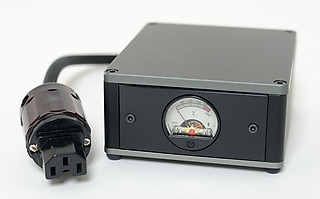
The Cleaner power conditioner
GL: In our opinion, it will work in all situations where you have an AC supply. It works best on pre-amps and source components (i.e. where there is voltage gain involved) and of course integrated amps. It is not current limiting in any way, so it also works very well for power amps.
JR: I gather that The Cleaner is intended for use with the Force, but would the Play it By Ear benefit from it as well?
GL: The Play It By Ear is multiple filtered on the supply side, but it would also work. However, The Cleaner is configured as an IEC in / IEC out product, so the plug format is not instantly compatible.
JR: To close out the interview, let’s get back to why we’re even talking about this in the first place – music. What do have in your playlists at the moment?
GL: Ah. One of those modern “digital audio” question. Playlists. Formats. File sizes. All attempts to get back to the original analog performance [winks]. You mean, what’s on my turntable? Marc Cohn’s first album. I’m playing “Walking in Memphis”.
SH: Oh man, I am kind of eclectic. I own over 18,000 rare records – which The Audio Nerd sells, but we listen to every one that gets sold. I also have a digital library of files ranging from MP3 to DSD 128 and all resolutions in between. And not always does it come down to recording quality. Currently I am listening to Billy Bragg’s latest album “Tooth and Nail”, Manchester Orchestra’s “Cope”, The Old 97’s new album Clutch, and Shiny Ribs. I also have a new-found appreciation for AC/DC, especially the Dirty Deeds album – the song “Ride On” is a passed-over masterpiece. And I’ve been listening to a lot more house and intelligent electronic music these days.
JR: Hah hah, thank you for correcting my inadvertent assumption, I’d not realized I was doing that! And thank you both so much for taking the time to respond to my questions. Best of luck with the campaign and the product launch.
The Indiegogo campaign for the Small Wonder components runs until January 11th, 2015. Visit the campaign at:



